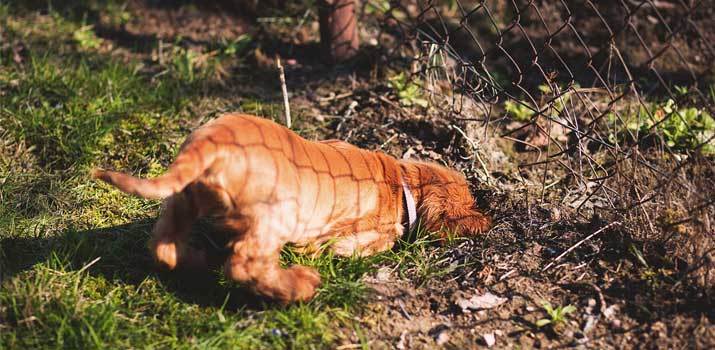
Digging is a fairly common behavior for dogs. Some breeds are more prone to turning your backyard into a potted mess than others, but all dogs are capable of doing some damage. It's an innate behavior that they're perfectly equipped for.
With their strong arms, sizable feet, and sharp claws, determined canines have no problem getting through some soil.
Therein lies the problem. While normal digging can be a nuisance that ruins your perfectly landscaped backyard,
the behavior can become dangerous if your dog starts to root under the fence.
Dogs are natural escape artists. While you might think that your dog is simply having fun digging in the dirt, it could be a ploy to get out of the confines of your yard.
So, how do you stop the behavior? Here are 14 appropriate solutions to the most common reasons why your dog is digging.
14 Ways to Get Your Dog to Stop Digging and Rooting Under the Fence
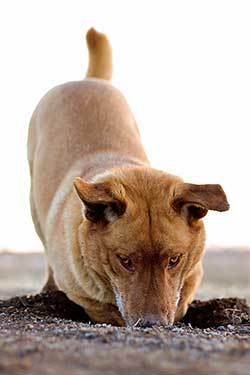
Now that you've identified the reason why your dog is digging, you can take the steps to put a stop to it! There are several ways to address the problem.
The first method to try will be the one that correlates for your pup's reasoning.
Of course, adopting several methods is a foolproof way to eliminate the problem altogether so that your dog stays safe and your yard stays pristine.
Here are some tips and tricks that you can try.
#1. Give Your Dog Things to Do
If your dog is digging out of boredom, the easiest thing you can do is just provide them with some mental stimulation.
Spending more time playing with your dog is ideal. But if that's not possible, try tossing some toys out there. You can also try interactive toys like puzzles or automatic ball throwers.
The goal is to keep your pup entertained so that they don't resort to digging. There are plenty of things you can do, so get creative and show your dog how to have fun on their own.
#2. Wear Them Out
There's no question that a lack of exercise can lead to destructive behavior.
Active dog breeds are notorious for going haywire if they don't get enough exercise throughout the day. You could try going on more walks or participating in rigorous exercise.
This doesn't mean that you have to create an agility course in your backyard! Just take a trip to the park and play a few rounds of fetch! This will tire out your dog and help keep them well-behaved.
#3. Keep a Watchful Eye and Interact with Your Dog
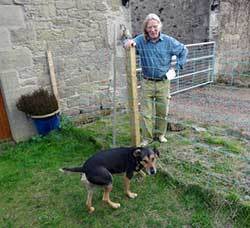
One of the best things you can do is to just be out there with your pup.
If you've already scolded your dog for digging, they're not going to push their luck when you can see them. Spend some time with your pup outside and interact with them regularly.
Not only will this keep them in check, but the constant attention you provide will ensure that they don't resort to bad behavior. It's a great way to bond with your pup. Plus, you can put a stop to digging whenever it starts.
#4. Implement Training Techniques
Speaking of watching your dog, it's a good idea to implement some training techniques early on. You don't have to get super fancy with commands. A simple, "Stop!" command will suffice.
Whenever your dog starts digging, simply provide the command in a firm tone. Eventually, your dog will get the point and not try it again.
You can use positive training techniques like that for a wide range of issues, so it's good to start early. Praise your pup whenever they listen.
Don't resort to yelling or hitting. Positive reinforcement is always better than punishment. At the end of the day, your dog wants you to stay happy, so they'll oblige.
#5. Provide Adequate Shelter
To solve comfort issues, you can provide a cozy spot for your dog to relax in. A backyard doghouse is a great choice. It's sheltered from the elements and is just small enough for your dog to feel safe in.
A high-quality house can be their safe space, which eliminates the need for digging. Even if you don't have room for a dog house, you can provide a nice bed.
Outdoor beds are a dime a dozen these days. They're simple, clean, and easy to set up. Just place the bed in some shade and your dog will have no problem using it.
#6. Create a Digging Spot
A dedicated digging zone pit is a great way to control your dog's digging under the fence habit without getting rid of it altogether. Your pup can get out that urge in a safe space that's away from the fence line.
It's fairly easy to create a digging pit. Essentially, it's nothing more than a dog sandbox!
Just remove the grass and landscaping from a large area, cover the soil with landscaping fabric to prevent weeds from popping up, and cover it with sand or soil.
We recommend creating a wooden frame to keep all that dirt contained, too.
Digging pits don't require a ton of money to make. However, that small investment will work wonders to keep your dog's digging under control.
#7. Use Deterrent Sprays on Your Fence
Deterrents are a great option if your dog is attracted to the fence line. You can use something like capsicum spray. It's like pepper spray.
The substance has a very strong odor that's unpleasant to dogs. They'll get a whiff and immediately back off!
There are several commercially available dog deterrents on the market. Of course, things like pepper and chili powder work well, too.
All you have to do is spray the bottom half of the fence and some parts of the soil next to it. That should be enough to keep your dog away.
#8. Add Some Fence Reinforcement
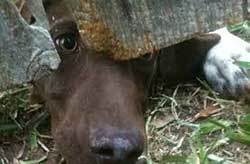
Once your dog starts digging under your fence line, they'll eventually create a gap that they can see through. This is when things start to get hairy.
Seeing that small gap will only push them to dig even more until they can get through! One tried and true method to deter fence-digging is to simply reinforce the bottom of the fence line.
Add a 4X6 piece of lumber directly under the fence line. Bury it at least 4 inches deep. We recommend doing this around gates and other access points, too.
Make sure that you're using a piece of landscaping lumber that can hold up to moisture. The last thing you want is your dog realizing they can get through rotted wood!
#9. Create a Physical Barrier
If a simple fence line barrier isn't enough, you can take things a step further by implementing an L-footer barrier. Basically, this is a simple barrier that you're going to bury underneath the soil to deter digging and prevent your dog from escaping.
To create this barrier, dig a trench that's one to two feet below the surface. It should extend about a foot from the fence line.
Now, you have a couple of options on how you want to proceed from here.
If you own both sides of the fence, you can extend that trench to a foot on the other side and lay a piece of chicken wire. The chicken wire should split the fence line, ensuring that your dog can't get past without coming into contact with the material.
If you don't own the other side of the fence, you can fold the chicken wire into an L shape.
Secure the vertical portion to the bottom of your fence and bury the rest about a foot out. Cover the chicken wire with soil and compact it down.
When your dog starts digging, they'll encounter the chicken wire. It's uncomfortable for your dog and creates a physical barrier they can't get through.
#10. Utilize Landscaping to Your Advantage
Landscaping is a great way to create a physical barrier that looks nice.
You can implement all kinds of decorative items along the fence line to ensure that your dog can't dig under. Your best bet would be to use large landscaping rocks.
Decorative rocks are strong and immovable. You can also try planter beds. However, determined dogs will not care about any flowers you have and can easily dig through.
#11. Block Their View
If sights and sounds from the other side of your fence are causing your dog to start digging their way to freedom, all you need to do is block their view! You can use a tarp or attractive landscaping fabric to cover fence panels.
It's a quick and easy fix that can work wonders.
#12. Modify Your Fence Design
An attractive alternative to using fabric would be to modify your fence design. Standard chainlink or picket fencing offers a lot of visibility, which could be problematic for your pup.
Even double-sided picket fences have small gaps your dog can see through.
Changing the design of your fence to something a bit more solid is a great way to keep your backyard distraction-free. You can try cement-block walls or full panelized fence systems.
#13. Use an Invisible Fence
Invisible fences are handy training devices that will not ruin your landscaping. They usually consist of an electronic training collar and perimeter control system.
The perimeter control system could be a central radial device or a long wire that's buried beneath the soil. Either way, invisible fences are specifically designed to keep your dog away.
As your pup approaches the perimeter threshold, their collar will emit a high-pitched tone that tells them to back off!
Some electric models are available as well that will deliver a light shock. Though, this could instill some fear into your dog, so we recommend sound-based systems instead.
#14. Add Another Layer of Safety
If all else fails, you can add a second layer of protection to ensure that your dog doesn't leave your property. Basically, your goal is to create a "fence within a fence."
One good option is to use an exercise playpen or large kennel. With this setup, your dog would still be confined in your backyard even if they dug underneath the first barrier.
Another trick you can try is to create an airlock. Often seen in dog parks and kennels, the airlock is just a transition period around the gate. It's a small fenced-in area with an additional gate at all access points.
Considering that the gate area is often the most-targeted by dogs, an airlock can do a lot to prevent accidental escapes.
5 Reasons Why Dogs May Dig
An Answer to Bordem
One of the most common reasons why dogs dig is simply because they're bored! When there's nothing else to do in your backyard, your pup can always fall back on the soil beneath them.
The interesting thing about digging is that it provides some much-needed excitement for bored dogs. When the soil is flying through the air and roots are springing back and forth, it's like the ground is playing with your dog!
Finding Comfort
Has your pup every "dug" at the carpet before? Chances are, they were doing so to get comfortable. They may be looking for a cozy spot to relax.
Digging is a way for them to loosen the soil and create a nice bed to lie down on.
In some cases, dogs will dig large holes that they sit in. It's kind of adorable and fun to watch. However, it's also a sign that your dog is probably overheated.
They often do this to create a cool spot. You might even notice that the hole they dig is under a tree or near the shade of your home.
Feeding Their Prey Drive
Dogs can dig whenever they see a small critter running by, too.
Canines have strong prey drives. It's why they chase squirrels and rodents! If your dog saw a small furry animal scurry by, their digging may be a concerted effort to knab that prey!
A Need to Escape
Here's another big reason why dogs dig.
Even the most well-trained pup will feel the urge to go beyond the confines of your yard every once in a while. They might have seen an animal through the slats of your fence or hear people walking by.
They want to go investigate, so they'll dig near the fence line! It's a way for them to try and get around the barrier that's blocking them from freedom.
A Call for Attention
Finally, your dog might just want attention.
If you've punished your dog before because they dug, they know that it's the perfect way to get your attention. This is a big red flag that you need to address.
If your dog is resorting to punishment to spend some time with you, you'll need to make some changes with how you interact with your canine companion.
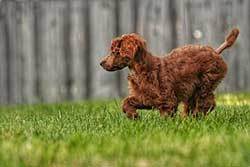
Conclusion
There you have it! These tips and tricks should help you have more control over your dog's digging habits. Dogs dig, It's a natural behavior. While it can be destructive and potentially dangerous, it's not always easy to put a stop to it.
The key is to focus your dog's energy elsewhere so that they can stay safe in your backyard at all times.
Also read:

